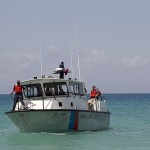On October 22, 1707, four ships and at least 1,400 seamen of Her Majesty’s fleet were lost off the Isles of Scilly near England; the primary cause was miscalculation of longitude. On the night of April 14, 1912, the “unsinkable” luxury liner Titanic sank with a loss of more than 1,500 lives when it struck an iceberg in the north Atlantic ocean. Over the course of Ron Johnson’s failed turnaround of JC Penney, over 20,000 jobs and $12 billion in market capitalization were lost. Common to all three disasters was a lack of situational awareness – awareness of surroundings and their potential impact.
In my four years as a volunteer with the U. S. Coast Guard Auxiliary, we received regular briefings on how to maintain situational awareness and on its importance. They were lessons that served me well sailing Lake Superior, and lessons that apply to leadership and organization effectiveness as well.
The USCGA’s definition of situational awareness is “the ability to identify, process and comprehend the critical elements of information about what is happening in a team and the environment with regards to the mission. More simply, it is knowing what is going on around you.” Clues to the loss of situational awareness include no one watching for hazards, failure to meet planned targets (or do anything about it,) unresolved discrepancies, and fixation or preoccupation. How many leaders and organizations have been blindsided because “no one was watching for hazards?” Was Ron Johnson so fixated or preoccupied with his untested and failed or failing JCP strategy that he lost situational awareness?
The USCGA points out these typical causes of poor situational awareness:
Faulty perception. We may not see or understand what’s really going on because we are expecting something else. For example, we might strongly believe that sales are low on account of poor promotion, when in reality a product just hasn’t hit the mark or is priced incorrectly. Or we miss something because we assume that it’s like something else we’ve experienced, but it isn’t. Ron Jonson likely expected that Penney’s retail market would respond to innovations like what he experienced at Apple, and missed the signals that it wasn’t going to. In some case our mental maps, or filters, get in the way of clearly seeing or interpreting what’s going on; we forget that “our map isn’t the territory.”
Excessive motivation. The drive might be so strong to achieve a certain end, that we ignore signs of danger or that a goal is unattainable. Mountain climbers call this potentially fatal condition “summit fever:” after an arduous journey and within sight of the summit, overly motivated climbers attempt the final ascent despite the approaching deadly storm. BP managers were likely experiencing a variation of “summit fever” when they missed critical danger signs before their Gulf rig exploded.
Complacency. In the immortal words of Mad Magazine’s Alfred E: “What, me worry?” After decades of growth, by 1980 General Motors and the American car industry had become complacent and discounted any threat posed by Japanese car manufacturers. Before it was too late, they didn’t see, or refused to believe, that car buyers actually preferred stylish, reliable economical and relatively trouble-free automobiles.
Overload and fatigue. Traffic fatalities due to texting reflect the drawbacks of multitasking. Experienced clowns might be able to juggle while riding a unicycle, but  the human mind is not wired to manage multiple conceptual tasks simultaneously, at least not well. Can anyone honestly say that they haven’t missed a thing when emailing while attending a meeting? Unreasonable workloads and overly stressed workers are unfortunate byproducts of recession-driven cost reduction measures; there comes a time when there is simply a limit to the volume and complexity of tasks that we can handle.
the human mind is not wired to manage multiple conceptual tasks simultaneously, at least not well. Can anyone honestly say that they haven’t missed a thing when emailing while attending a meeting? Unreasonable workloads and overly stressed workers are unfortunate byproducts of recession-driven cost reduction measures; there comes a time when there is simply a limit to the volume and complexity of tasks that we can handle.
Distraction. Without focus and discipline, today it is easier than ever to be distracted from what matters most; the trick is not falling prey to “the trivial many at the cost of a vital few.” (Pareto’s Principle) When executing a jibe in challenging weather, focusing only on properly setting sails without checking for surrounding traffic can be disastrous. (See “Paying Attention To What Matters”) When workers are distracted by threats of layoffs, turf battles, unreasonable pressure to achieve short-term targets or unsafe working conditions, it’s likely that they will overlook something of importance.
Poor communication. Stories told about the 1707 Scilly naval disaster include the flogging of a common seaman earlier in the voyage when he questioned an officer’s calculation of position. (He was reportedly a local who likely knew the currents and conditions better.) How likely would it be after such an incident that any common seaman dared again to raise concerns or questions? Flogging has been replaced with more modern penalties in some organizations for questioning leadership or bearing bad news. Barriers to communication need not be so offensive to cause damage; in many cases they are products simply of misunderstanding. For that reason the Coast Guard, hospitals and other settings where situational awareness is critical have adopted a practice that originated with aviation: the “two challenge rule:” If someone fails to adequately respond to two or more challenges about questionable observations or actions, it should be assumed that situational awareness has been lost and there is a need for remedial action.
Here are some strategies for improving situational awareness:
- Make sure that all understand its importance, and how it is everyone’s responsibility. Develop situational awareness capabilities.
- As the philosopher and propaganda expert Randal Marlin advised: “The pursuit of truth is like picking raspberries. You miss a lot if you approach it from only one
 angle.” Coast Guard patrols post crew at all quarters necessary for a complete picture of surroundings. If there are discrepancies or disagreements about observations or their interpretation, consultation generally improves decisions. Likewise, situational awareness and resulting action planning shouldn’t be only senior leadership’s, strategic planners’ or marketing’s domain.
angle.” Coast Guard patrols post crew at all quarters necessary for a complete picture of surroundings. If there are discrepancies or disagreements about observations or their interpretation, consultation generally improves decisions. Likewise, situational awareness and resulting action planning shouldn’t be only senior leadership’s, strategic planners’ or marketing’s domain. - Pay attention to the quality of communication channels for utilizing observations and information. Make sure there are no barriers, conscious or not, for the free-flow of observations, feedback and “bad news.” (Because you think there are none usually isn’t sufficient; use “360s” and climate surveys to check it out.)
- Empower team members to take necessary corrective action when they observe errors or factors critical for success. Jidoka, one of Toyota’s core manufacturing principles, includes giving production workers control to stop production lines when problems occur. The outcomes of BP’s burning Gulf platform would have likely been much different had that principle been practiced.
- Monitor stress levels; do a reality checks on workloads, and help prioritize tasks to reduce the fatigue, stress and distractions that negatively impact situational awareness.
- Take time periodically to “scan the horizon” and pay attention to any potential critical factors – especially when things are going well (encroaching competitors, regulations, shifting tastes or environmental / market conditions, etc.)
In my book “Navigating Integrity . . ..” I describe how Authenticity is one of four dimensions required to cultivate engaging, ethical and effective work cultures. We want “real leaders” and “real organizations” that live up to who or what they claim to be. There is another side to being real as an organization or leader, however; that is the capacity to accurately assess and interpret what is really going on – in other words, situational awareness. We would enjoy exploring ways to enhance your leaders’ and organization’s capacities for situational awareness as a resource for strategic planning, “360” / organization surveys and tailored leadership development.

“Sometimes, leadership differs from non-leadership only in that leadership views the world with a slightly larger lens.”
John Carver
Seeing the world through the largest number of lenses makes it unlikely that some new reality will appear without being aware of it at all.
Robert Theobald
